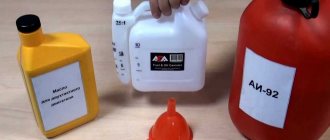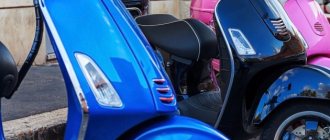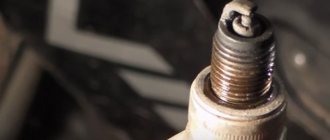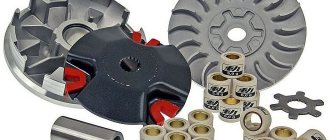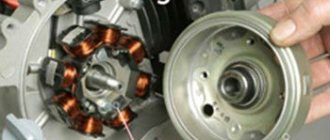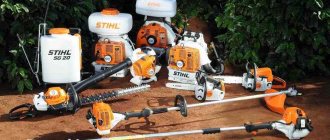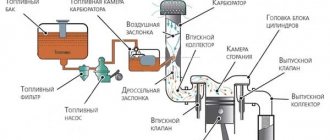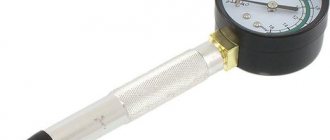Scooter engine - device Scooter carburetor - device, setup Scooter crankshaft Scooter gearbox - device Scooter clutch - device, setup Scooter variator - device Scooter chain drive device Scooter electrics Scooter brake system Switch - electronic ignition of the scooter Scooter speed limiters
Advantages of four-stroke engines
| Advantages of two-stroke engines
|
Motorcycle device
The main components that give you a feeling of freedom on the track:
- chassis;
- engine;
- transmission;
- optional equipment.
The chassis or carriage has the following components:
- The frame is the main strength element that secures the components of the motorcycle.
- rear suspension – suspension of the rear wheel, and also makes it possible to obtain maximum driving comfort;
- front fork – attached to the frame. Suspends the front wheel when moving on uneven surfaces, which smoothes out shocks.
- braking system - used when reducing speed or forcibly stopping the motorcycle.
- Wheels are the components that make a motorcycle ride.
Engine (motor) – produces energy used to move the motorcycle. Motorcycles have two-stroke and four-stroke engines.
The transmission (power train) is designed to transfer energy from the engine (motor) to the wheel. The transmission consists of:
- gearboxes;
- clutch;
- main gear.
Additional equipment may include:
- anti-theft devices (alarm, locks);
- control units for main devices;
- protective devices (shields, headlights, side lights, etc.);
- trunk;
- passenger seat, etc.
Now you know more about your motorcycle. We hope the above has been useful to you. Take care of yourself and be extremely careful on the road.
If you have any questions, the instructors of the RSmoto motorcycle school will be happy to advise you.
Scooter engine noise - theory and consequences
Like any other internal combustion engine, a scooter engine is subject to wear and tear. This is a natural process and over time you will inevitably hear extraneous noises in the operation of the scooter’s engine, which one way or another may indicate rapid wear of the engine or transmission components.
The sounds can be different, from hissing to rumbling, from the usual clattering to a loud howl. Let's consider the main ones:
- In a four-stroke engine, the thermal clearances in the valve drive mechanism may have been damaged; in this case, the valves must be adjusted. The gaps must be set to those specified by the manufacturer.
- If your scooter is two-stroke and carbon deposits have formed in the combustion chamber, preventing normal operation of the engine, you hear detonation, the combustion chamber needs to be cleaned. To do this, remove the cylinder head, the cylinder itself, and use a wooden spatula to remove carbon deposits inside the cylinder windows and from the piston bottom. It is not necessary to remove the piston itself, just plug the hole in the crankcase with a small rag. In some cases, when the coking of the combustion chamber is insignificant, fuel additives that are specially produced for these purposes help.
- When the cylinder-piston group wears out, the gap between the piston and cylinder increases. At the same time, a peculiar clattering sound is heard when the piston skirt seems to be dangling in the cylinder. This phenomenon can often be found on Hondas with vertical engines.
- If the elements of the CPG are not tightened enough, you can hear a characteristic hissing and whistling. This is the sound of gases escaping. At the same time, the engine runs unstably and compression drops significantly. To fix this breakdown, you need to tighten all the engine threads and check the integrity of the gaskets. Particular attention should be paid to the condition of the gasket between the cylinder head and the cylinder.
- Wear of crankshaft bearings is one of the most labor-intensive breakdowns. To replace the bearings, you will need to “prick” the engine, and this is beyond the power of an amateur scooter rider. The sound when the bearings wear out cannot be confused with anything - it is a howl when gas is added. The howling can be short-lived, it can appear immediately from the start, or maybe after a few kilometers of travel. If the bearing has shattered, you may hear a characteristic cracking sound when there is strong gas release on the center stand. Worn upper and lower connecting rod heads also produce strange noises when the scooter engine is running. Repair consists only of replacing damaged parts.
- In a four-stroke engine, the valve train drive chain may become loose. At the same time, you will also hear an extraneous clattering sound, which is eliminated by proper chain tension. Perhaps the chain has already worn out, then it needs to be replaced.
How is a motorcycle designed and how does it work?
- » rel=»nofollow»> Print
Date Category: Transport
Like a car, a motorcycle “eats” gasoline to get energy for its movement. The significant difference between them is that a motorcycle has only two wheels. The engine's energy is transferred to the rear wheel. And although its power is often much less than that of a car engine, a motorcycle, thanks to its streamlined profile and lighter weight, can reach the same speeds as a car. In addition, motorcycles usually accelerate faster than cars and are more agile on narrow roads and off-road.
Advantages and disadvantages of two and four stroke engines
Two-stroke advantages 1. Less weight. Example: 15 hp Two-stroke 36 kg four-stroke 45 kg. 2. Price. Four-stroke engines are more difficult to manufacture, consist of more parts, and therefore are always more expensive than two-stroke engines. 3. Ease of transportation of a two-stroke. Can be carried in any position and does not require weighing before use. Those. took it out of the trunk, put it in, started it, and drove off. 4. A two-stroke engine responds more quickly to the throttle. In four-stroke engines, to complete a full working cycle, the piston needs to make 2 full revolutions, while in two-stroke engines only one. Frequently asked question: Is it true that a four-stroke engine has 15 hp? runs faster than the same two-stroke? Answer: no, not true. Both of these engines have 15 hp at the shaft. All other things being equal, why should one engine go faster than the other?
Motorcycle diagram
How energy is transferred to the wheel
The operation of a motorcycle engine is in many ways similar to that of a car engine. The fuel burned in the engine cylinders pushes the pistons (in the picture above), which rotate the crankshaft. In a gearbox, the rotational movement of the crankshaft is transmitted to the chain. It is she who turns the rear wheel. But a motorcycle also needs a gearbox: to reduce the too high rotation speed received from the engine. And finally, the rear wheel makes one full revolution per two revolutions of the crankshaft.
Combustion and expansion (piston stroke) - four-stroke engine
Shortly before the end of the compression stroke, the combustible mixture is ignited by a spark from the spark plug. As the piston moves from TDC to BDC, the fuel burns, and under the influence of the heat of the burned fuel, the working mixture expands, pushing the piston. The degree of “under-rotation” of the engine crankshaft to TDC when the mixture is ignited is called the ignition timing angle
. Ignition advance is necessary so that the gas pressure reaches its maximum value when the piston is at TDC. Then the use of energy from burned fuel will be maximum. The fuel combustion rate practically does not change, that is, it takes a fixed time, therefore, in order to achieve maximum engine performance, you need to increase the ignition timing in proportion to the crankshaft speed level. In older engines, this adjustment was made by a mechanical device (centrifugal and vacuum regulator acting on a breaker). More modern engines use electronic ignition timing to adjust the timing.
To make it easier to move
The spring suspension system is installed on both wheels of the motorcycle. It protects the motorcyclist and the engine from impacts due to uneven roads.
Front wheel suspension
Shock-absorbing springs are hidden inside hollow oil-filled forks. These springs reduce shock and vibration.
Rear wheel suspension
The rear shock absorption mechanism is attached to the motorcycle frame itself - one on each side of the wheel.
Two-stroke engine gives more power
Cars usually use four-stroke engines. Their operating cycle consists of four parts: mixture intake, compression, combustion and exhaust. This requires two movements of each piston back and forth. A two-stroke motorcycle engine (picture above) performs all the same operations in one complete back-and-forth motion of the piston: As the piston rises (left picture), intake and compression occur. And when it goes down, combustion and exhaust (right picture). Therefore, theoretically, at the same speed, that is, the same number of revolutions per minute, a two-stroke engine should be twice as powerful as a four-stroke engine. However, in practice, due to the size of the two-stroke engine and the increased friction in it, its advantages are not so great. And yet, the power of a two-stroke internal combustion engine is approximately 1.5 times higher than the power of a four-stroke one.
Compression - 4-stroke engine
The piston of a four-stroke engine rises from BDC to TDC, compressing the working fuel mixture. At the same time, the temperature of the combustible mixture rises significantly. The ratio of the working volume of the cylinder at BDC to the volume of the combustion chamber at TDC is called the compression ratio (not to be confused with compression). The compression ratio is a very important parameter; usually, the higher it is, the greater the fuel efficiency of the engine. But a four-stroke engine with a higher compression ratio requires fuel with a higher octane number, which is more expensive.
What does a moped consist of?
Have you dreamed of owning a motorcycle for a long time and finally decided to buy it?
Great! Do you know how to ride it? I think you have a lot of questions about this. To learn how to control a motorcycle at a high level and cope with any difficult situations on the road, you first need to learn the basics of the structure of the vehicle and its functioning system. Only having mastered theoretical knowledge can you begin to master practical skills.
A motorcycle consists of various parts. They are considered universal because, regardless of the brand or model, they are present in the structure of all motorcycles.
Carburetor fuel supply system
Principle of operation
A design option for the fuel supply system is shown in the figure.
Fuel supply system to the carburetor: 1 - channel connecting the float chamber to the atmosphere; 2 - float guide; 3 — float; 4 — lever for interaction with the fuel valve; 5 — fuel supply fitting; 6 - mesh filter; 7 — valve seat; 8 — valve needle; 9 — swing axis of lever 4
The fuel coming from the tank is maintained at a constant level inside the float chamber. The float and the valve associated with it are responsible for this. The float moves freely along with the fuel level, thereby adjusting the flow area of the valve. As the engine consumes fuel, the level in the float chamber decreases, the float lowers and opens the valve, thereby allowing fuel to flow from the tank. The fuel level begins to rise, the float rises and closes the valve at a certain point, after which the process repeats.
General view of the float chamber (a), fuel valve (b)
In this way, it is possible to maintain an almost constant pressure of fuel to the various jets. In other words, the height to which the fuel must rise to begin atomizing under the influence of rarefaction remains constant. The figure shows a carburetor in cross-section showing the main systems. The fuel level maintained in the float chamber is highlighted in yellow.
Carburetor cutaway showing the main systems
Design and adjustment methods
Let's take a closer look at the system: float - valve.
The fuel valve consists of a shut-off needle and seat that is pressed or screwed into the carburetor body. The tip of the needle is rubberized. The rubber composition is well compatible with commercial gasoline, but when using specialized fuels, such as alcohol-containing fuels, it is necessary to ensure compatibility with seal materials to ensure that carburetor performance is not compromised. Many lock needle designs use a spring pusher that interacts with the float to reduce needle vibration caused by the movement of the motorcycle and the movement of fuel in the float chamber.
Fuel valve
The flow area of the fuel valve is a control parameter, as it determines the maximum fuel consumption. If the cross-section is too small, the float chamber may empty because the fuel flow will exceed the fuel flow under the current operating conditions of the engine (usually at full load). After operating for some time in this mode, the engine may fail due to the leanness of the combustible mixture.
The fuel level is also an adjustment parameter of the carburetor, which follows from the principle of operation, since the dosage of fuel consumption changes with the level, thereby affecting the composition of the mixture.
The fuel level is adjusted by changing two parameters:
- float weight;
- the geometry of the lever connecting the float to the valve.
By installing a heavier float, the fuel level will increase due to compensation for its lower buoyancy.
This will lead to a richer mixture if other parameters are not changed. In the opposite situation, when installing a lighter float, the fuel level will decrease due to a decrease in buoyancy force. This will cause the valve to close early and reset the carburetor to a leaner mixture. Therefore, floats are classified by weight and must be installed at the appropriate height as per prescribed standards. The method for controlling the installation height of the floats is shown in the figure. When it is necessary to adjust the level and it is not possible to change the weight of the float, you can change the geometry of the lever acting on the valve. In this case, the float will close the valve earlier (at a lower level) or later (at a higher level) with the same weight.
Measuring the float installation height
Features of working conditions
A high fuel level, just like a low one, affects the operation of all carburetor systems in all engine operating modes.
However, it should be noted that too low a fuel level in the float chamber can lead to insufficient fuel pressure at the nozzles, which will cause a lean mixture that is dangerous for engine operation. This can occur when fuel moves within the float chamber during accelerations the vehicle is subjected to. In this case (which mostly happens on off-road or track bikes when cornering and hard braking), if the level is too low, one of the jets may suddenly become airy. To prevent such a situation, some designs use special deflectors around the jets, they are also called dampers (an example of such a device will be given in the next publication). The purpose of the damper is to keep as much fuel as possible close to the jet under all possible operating conditions.
To be continued…
Motorcycle device
Description of the main components of the motorcycle, rules for their operation and recommendations for simple repairs and maintenance. This material will be useful to novice motorcyclists.
Motorcycle engine. Motorcycle engines are 2-stroke and 4-stroke. A positive feature of 2-stroke engines is their large liter power. The negative side is an increased requirement for lubrication, and as a result, a low service life. The separate lubrication system consists of an oil tank and a pump combined with a dosing mechanism. This device supplies oil in a ratio of 1 to 60, 1 to 100, so if you do not use special 2-stroke oil, the engine will fail. The design of 4-stroke motorcycle engines is similar to automobile engines, but, as a rule, the engine is combined with a gearbox and has a single lubrication system. It is recommended to change the oil and oil filter after 5-10 thousand kilometers or once a season. Use special oil for 4-stroke engines, since the motorcycle clutch operates in an oil bath, and some automobile oils contain additives that form surface films, which can lead to premature wear of the discs. The gas distribution mechanism requires periodic adjustment. The most common method is a screw with a lock nut on the rocker arm or rocker arm. There is an adjustment using washers that are placed under the pusher cup, as on a VAZ 2108 car. Engines with hydraulic compensators do not require maintenance of this mechanism. Valve clearances are usually set: for liquid-cooled engines, 0.08 -0.1 mm at the inlet and 0.1-0.15 at the outlet. For air-cooled engines they are slightly larger: 0.1-0.15 at the intake, 0.15-0.25 at the exhaust. This is average data. Often, poor compression is associated with missing or incorrect valve clearance.
Motorcycle cooling system. The water cooling system of 2-stroke and 4-stroke engines usually has a forced-air radiator fan. It turns on when the temperature rises above 85 - 90 degrees. If the temperature rises above 100-105 degrees (red zone on the sensor) and the fan does not turn on, check the fuse. If it is intact, you need to check the fan switch sensor, which is usually located at the bottom of the radiator. To check the switching on, it is enough to connect the terminals removed from the sensor together, and if only one wire fits, connect it to ground. The fan should start working. If it turns on, but when the motorcycle overheats it does not rotate, then the sensor must be replaced. The fan may also not turn on due to poor coolant circulation or low coolant level.
For air cooling systems, an indispensable condition for normal engine operation and its longevity is the condition of the air filter. A dirty filter does not allow the engine to develop the required speed, power drops, and fuel consumption increases. This filter should be changed. The filter, made of foam rubber, must be washed periodically. After drying, the filter must be soaked with special filter oil. If this is not done, it will lose its filtering properties.
World of scooters.
Models, selection, tuning, repair and driving. >> Design and principles of operation. Engine. Contents :: Next >>
Design and principles of operation
All types of scooters can be divided into two classes - with two-stroke and four-stroke engines. The design and operating features of all systems are also determined by the type of engine.
Piston internal combustion engine: 1 - cylinder head; 2 - cylinder; 3 - piston; 4 — connecting rod; 5 - crankshaft; 6 - crankcase; 7 - spark plug. Combustion chamber volume Total volume Working volume Piston stroke TDC BDC.
Principles of operation of internal combustion engines
A mixture of fuel and air, also known as the combustible or working mixture, prepared in the carburetor, is sucked into the engine cylinders, then compressed by the piston and ignited by an electric spark from the spark plug. When the mixture burns, the expanding gases press with great force on the piston located in the cylinder. The reciprocating motion of the piston is converted into rotation of the crankshaft through a crank mechanism. The flywheel, attached to the end of the crankshaft, smoothes out the unevenness of its rotation and accumulates the kinetic energy necessary for the movement of the piston in the cylinder during non-working strokes. The extreme positions of the piston moving in the cylinder are called dead centers - top dead center (TDC) and bottom dead center (BDC). The distance from TDC to BDC is called the piston stroke, and the space created is called the cylinder displacement. The total internal volume of the cylinder is the sum of the working volume and the volume of the combustion chamber above the piston. The ratio of the total volume to the volume of the combustion chamber is called the compression ratio; the higher it is, the more efficient the engine's operating process is. Modern scooter engines have a compression ratio of 8.5-10 units. Scooter engines are divided according to the method of operation into two-stroke and four-stroke, and both types have both advantages and disadvantages. A two-stroke engine is structurally simpler than a four-stroke engine, since it does not have a valve control mechanism and a pressure lubrication system.
Scooters are equipped with internal combustion engines (ICE), in the cylinders of which the thermal energy of the burning fuel-air mixture is converted into mechanical work. Although many companies are experimenting with other energy sources - electric and fuel cells, it is too early to talk about their widespread use on scooters.
On scooters with large engine displacements, four-stroke engines are more often used due to their advantages in torque flow, greater efficiency and, most importantly, less toxicity.
Working process of a four-stroke engine: a - intake; b - compression; c — expansion (working stroke); g - release; 1 — inlet valve; 2 - spark plug; 3 - exhaust valve.
Four-stroke engines
In these engines, the working cycle occurs in four piston strokes (stroke) and two revolutions of the crankshaft: intake - the piston descends from TDC and sucks in the combustible mixture through the open intake valve; compression - the piston rising from BDC compresses the combustible mixture with the valves closed; working stroke - the mixture burns, ignited by an electric spark, and the resulting gases, expanding, move the piston down (this stroke of the piston is called working, since useful work is done at this time); exhaust - the upward moving piston pushes the exhaust gases through the open exhaust valve.
Two-stroke engines
In two-stroke engines, unlike four-stroke engines, the working cycle occurs in one revolution of the crankshaft. Another feature is the absence of valves (intake and exhaust) with a mechanical drive. Their role is played by the piston itself, opening and closing special windows on the surface of the cylinder. The crankcase volume under the piston is also used for gas exchange. As the piston moves upward from BDC, the volume under the piston increases and a vacuum is created in it. Under its action, the combustible mixture enters the sub-piston space. At the same time, the upward moving piston displaces the exhaust gases remaining from the previous cycle from the cylinder. Simultaneously with the displacement of these gases, the working mixture enters the cylinder, which got here during purging, which will be discussed a little later. As the piston moves upward, it closes the bypass windows on the inner surface of the cylinder, as a result of which compression of the combustible mixture begins in the volume above the piston. At TDC, the mixture in the combustion chamber is ignited by an electric spark. The burning air-fuel mixture expands and pushes the piston down - a working stroke is completed. Having descended approximately 2/3 of its stroke, the upper edge of the piston opens an exhaust port on the surface of the cylinder. Exhaust gases under excess pressure exit through this window into the exhaust pipe. Through other windows, a fresh charge of the combustible mixture enters the cylinder from the crankcase cavity, where the descending piston creates excess pressure. This flow of mixture is called purging, and windows and channels are called purging. Modern two-stroke engines have multi-channel (3-5 channels) return-loop blowing. In addition, a check plate (petal) valve is installed at the inlet of the cylinder, which is controlled by the vacuum in the crankcase. During intake (the piston moves from BDC to TDC), under the influence of vacuum in the sub-piston space, the valve plates open the passage of the combustible mixture from the carburetor. When the piston moves back (during purging), excess pressure in the crankcase presses the valve plates against its body, preventing the mixture from being thrown back from the crankcase into the carburetor.
The working process of a two-stroke engine: a - inlet into the crank chamber, compression in the cylinder; b - ignition (before TDC) and subsequent combustion in the cylinder; c — release of exhaust gases from the cylinder and purging with a combustible mixture from the crankcase; 1 - purge channel; 2 — exhaust channel; 3 - spark plug; 4 — petal valve in the inlet channel; 5 — inlet channel; 6 - crank chamber.
Cylinder
The piston moves along the inner surface of the cylinder, called the cylinder surface. Until recently, scooters used solid cast iron cylinders, although on motorcycles this material was abandoned long ago due to its greater mass and worse heat dissipation than aluminum. In scooters, forced air cooling prevents the cast iron cylinder from overheating, and the deciding factor in favor of using the latter is the lower cost of a solid cast cylinder (aluminum cylinder requires an insert liner). In modern engines, hard-alloy nickel-silicon compositions (“Nikasil”) are applied to the aluminum cylinder base, abandoning the use of steel or cast iron liners. Depending on the type of cooling system adopted, the jacket (outer surface) of the cylinder has fins (for air cooling) or internal cavities for the passage of coolant.
The reed valve improves cylinder filling, increases engine power and efficiency, especially at low and medium crankshaft speeds.
The design of a two-stroke engine ensures that the exhaust gases and the combustible mixture are located separately in the cylinder.
External view of the reed valve.
Piston
This important part of the cylinder-piston group perceives gas pressure during combustion of the working mixture. The piston consists of a bottom, upper and lower parts (head and skirt, respectively) and piston pin fixation bosses. The shape of the bottom can be flat or convex; four-stroke engines often have recesses in the bottom for valves. Two-stroke engines have cutouts in the piston skirt through which the combustible mixture passes, since in these engines the piston controls the gas distribution (intake, scavenging and exhaust). The piston head has thickened walls, where two (less often one) compression rings made of special cast iron or steel are placed in special grooves. These rings seal the gap between the piston and the cylinder bore, and also remove heat from the piston into the cylinder. The bosses serve as a support for the piston pin, they have grooves for circlips and holes for lubricating the pin with oil mist. The skirt directs the movement of the piston.
Piston pin
It pivotally connects the piston to the connecting rod. Typically, a floating pin fit is used in the piston bosses and the upper head of the connecting rod; it is secured against axial movements by spring retaining rings installed in the piston bosses.
Reed valve diagram: 1 - reed valve body; 2 - limiter; 3 - elastic plate.
connecting rod
This part transmits force from the piston to the crankshaft and consists of a rod (I-beam or elliptical section) and heads: upper and lower. Depending on the type of engine and the lubrication system used, the connecting rod heads are made with plain bearings (with bronze bushings or liners) or rolling bearings (roller, needle). When a sliding bearing is used in the lower head, the head itself is detachable.
Crankshaft
Receives force from the piston (via the connecting rod), converts it into rotational motion and then transmits torque to the transmission. In addition, other systems and mechanisms are driven from the crankshaft: gas distribution mechanism (GRM), oil pump, generator, cooling system pump, balance shafts (if provided for by the design). The crankshaft of a single-cylinder engine (and the vast majority of such engines on scooters) has one elbow formed by two cheeks and a connecting rod journal. The ends of the shaft, or journals (also called journals), rest on bearings.
Piston (1), needle bearing (2) and piston pin (3) of a two-stroke engine.
In four-stroke engines, in addition to compression rings, the piston has an oil scraper ring that removes excess oil from the cylinder bore.
Due to the unequal thermal expansion of different parts of the piston, its outer surface is given a complex shape at the factory: barrel-shaped (conical) in height and oval in circumference. Pistons are made from high-quality aluminum alloys with a high silicon content, which can withstand high thermal and mechanical loads, and at the same time have a low expansion coefficient.
Piston and crank mechanism of a two-stroke engine: 1 - crankshaft; 2 - piston; 3 — compression rings; 4 — expander ring of the upper piston ring; 5 — piston pin retaining rings; 6 — piston pin; 7 — connecting rod.
Balancing
Any piston internal combustion engine, and especially a four-stroke single-cylinder, has high uneven operation. This is due to the fact that only one stroke of the piston is working, and the rest - one for a two-stroke engine, and three for a four-stroke engine - require energy expenditure. To improve the smooth operation of the engine, the crankshafts have an external flywheel, massive cheeks and counterweights.
Carter
Most often it is formed in two parts, with a longitudinal parting plane. In four-stroke engines, the crankcase (or sump) is usually a reservoir for oil draining from lubricated parts.
Diagrams of gas distribution mechanisms: a - ONS, b - DOHC: 1 - cam; 2 - pusher; 3 — rocker arm (rocker).
Gas distribution mechanism (GRM)
The periods of time when the intake and exhaust valves are open are called valve timing; they are coordinated with the piston strokes. Gas distribution in four-stroke internal combustion engines is controlled by a camshaft (or camshaft), which rotates twice as slow as the crankshaft. When rotating, the camshaft interacts with its cams with pushers, which directly or through a transmission link (rocker arm, rocker) open the valves (intake and exhaust); their closure occurs under the action of valve springs. To better fill the cylinder with the combustible mixture, the intake begins when the piston has not yet reached TDC. As the piston continues to move from TDC to BDC, it sucks in the combustible mixture through the open intake valve; they complete the intake after passing BDC, when part of the mixture enters the cylinder by inertia.
On modern four-stroke scooter engines, as a rule, two types of timing belts are used: OHC and DOHC. Engines with OHC type timing belts have an “upper” camshaft that acts on the valve tappets through levers (rockers). Modern multi-valve heads with four valves per cylinder often use two camshafts, each with its cams directly acting on the valve lifters (DOHC design). This design has a minimum of reciprocating moving parts. Because of this, the inertia of the valve drive is reduced, which makes it possible to increase the engine crankshaft speed, and hence its power. For normal operation of the valve mechanism, there must always be a thermal gap (0.05-0.15 mm) between the valve stem and its drive. When there is no clearance, the valves do not close tightly, as a result of which they burn and fail. With an increased gap, they do not open completely, which causes knocking and, in addition, power is lost. Many engines of modern scooters have timing belts with hydraulic compensators that automatically maintain the required valve clearances. They are driven by oil from the lubrication system. In engines without such a system, the timing gap is adjusted during maintenance.
Design of the valve drive in the DOHC circuit: 1 - adjusting washer; 2 - pusher; 3 - crackers; 4 - outer spring; 5 - valve.
In modern engines, to reduce vibrations, special balancing shafts are sometimes installed, which are driven by a gear transmission from the crankshaft.
Design features of modern engines
Over the past few years, four-stroke engines have become prevalent in 50cc scooters. Currently, in developed countries, scooters with two-stroke engines have limited use, mostly older models. In the foreseeable future, a complete ban on the production of these engines is expected due to the high toxicity of exhaust gases. The exception is the motors that scooters are equipped with. The engines of these scooters are equipped with a Ditech-Direct power supply and gas distribution system (direct injection of the fuel-air mixture into the combustion chamber and purging of the cylinder with a mixture of air and oil).
Diagram of a camshaft drive by a chain: 1 - chain; 2 — chain damper; 3 — camshaft sprocket; 4 — chain tensioner shoe; 5 - tensioner; 6 — crankshaft sprocket.
The layout of scooter engines is not very diverse. The engines of the vast majority of scooters have one cylinder, except for engines with a displacement above 500 cm3 - two-cylinder in-line and V-shaped designs are used here. Among small-capacity cars, the exception is the Italjet Formula Twin 125 scooter, which has a 114.5 cc two-stroke engine with two cylinders. Considering that in most countries there is a legal limit on the maximum speed of “small” scooters to 50 km/h, many companies install various kinds of limiters (in other words, they “strangle” the motors). Removing factory limiters is one of the areas of scooter tuning, which is discussed in more detail at the end of the publication. Scooters with an engine displacement of more than 50 cm3 do not have such restrictions. Thus, the Suzuki Burgman AN650, with an engine displacement of 638 cm3, has a power of 55 hp. With. at 7000 rpm. Scooter engines, especially large ones, are liquid-cooled, have four-valve cylinder heads with two overhead camshafts, and a fuel injection system. Engines with two-valve heads and carburetors are considered obsolete. To reduce the toxicity of exhaust gases, catalytic converters and a clean air supply system for afterburning toxic compounds are increasingly being installed in the exhaust system.
On an experimental basis, the Honda Julio and Crea Scoopy models are equipped with an Idle-Stop system to automatically turn off the engine if it idles for more than 3 seconds. In this case, the engine is started by turning the gas handle.
Promising two-cylinder four-stroke Piaggio engine.
Cleaning the cylinder from exhaust gases begins when the piston has not yet reached BDC, and there is excess pressure in the cylinder. As the piston moves from BDC to TDC, the piston pushes exhaust gases out of the cylinder through the exhaust valve. The exhaust valve closes after the piston passes TDC to allow some of the exhaust gases to leave the cylinder by inertia. Thus, there is a period of time when both valves are open - this is called "valve overlap". Each four-stroke engine model has its own optimal valve timing, which is determined by the profile of the camshaft cams. The most advanced engines have special devices that make it possible to change the valve timing depending on the crankshaft speed.
Valve timing diagram of a four-stroke engine: 1 - opening of the intake valve; 2 - closing the intake valve; 3 - closing the exhaust valve; 4 — opening of the exhaust valve; angle a - valve overlap. Spark discharge vmt nmt.
Contents :: Next >>
Bike diagram for a beginner
This section is intended to describe the scheme of motorcycle equipment for beginner lovers of two-wheeled horses. The following brief visual information will help you understand the simplest steel horses. This is exactly what the bikes of the 1960s looked like. from the world's leading manufacturers of similar products. Moreover, this applies to former motorcycle legends and modern brands of iron horses. Using this picture you can study the history of the structure of motorcycles.
The first number in the diagram shows the front shock absorber fork. However, you will not see the springs themselves in the front part of the motorcycle, since the latter are hidden under an iron casing called pants. Number 2 indicates the dashboard light indicator lamps. In older bike models they were installed directly on the top of the headlight. The third number is the speedometer.
Number 4 is represented by the front brake drive handle. 5 is a (gas) handle that changes the fuel supply level using the throttle. Number six indicates the clutch lever. 7 - gas tank. 8 - air purifier. This is exactly what his old samples looked like. Number 9 in the picture is represented by the rear shock absorbers. 10 — exhaust pipe (namely “muffler”).
Number 11 will show you the rear fork (swingarm). 12 is a chain (chain drive). Number 13 indicates the engine (its crankcases). 14 is represented by a leading star. 15 is the motor chain. Number 16 indicates the left crankcase (motor) cover. 17 - piston. 18 - cylinder (popularly referred to as “piston”). Number 19 on the motorcycle diagram shows the brake pads of the front wheel drum. Well, 20 is the front wheel drum itself.
More elegant motorcycle schemes
In the list of unusual pictures, where a motorcycle is schematically depicted, you can also find a drawing of a cross-shaped bike.
This brainchild of modern science and technology is replete with an abundance of unusual things, from the design of its entire structure to the shape of the engine and the number of its cylinders. The X-shaped engine looks cool and is capable of producing a lot of power. Unfortunately, few people have yet been able to verify in practice the superiority of this model of the iron horse, since these days mainly steel horses with boxer, in-line and v-shaped engines are produced en masse.
To assemble such a miracle of technology yourself, you need a lot of money and a lot of free time. And the main thing you need to stock up on is the desire to create something original in motorcycle mechanics. Still, the decisive role in the design process for creating motorcycles remains with finance.
Be that as it may, the rest of the design of such a motorcycle remained virtually unchanged. Same chain drive, same pair of wheels. The X-shaped engine is located where other types of motors are installed - under the frame and between two wheels. Perhaps the only thing missing from the bike diagram is the fuel tank and a normal seat. Still, the designers left the place for both to your discretion and imagination.
Motorcycle electronics circuit
Well, the picture indicated at the bottom of this section describes in detail the electronic system of the bike. It clearly indicates the main components that generate current and the main consumers of the latter. In addition, this picture demonstrates in a clear perspective the connection between the above parts of the motorcycle.
We think all of you have already guessed that these are electronics drawings for a single-cylinder motorcycle model. In addition, everyone can probably see that this is an old domestic bike that has been out of production a long time ago. However, fans of such transport have not sunk into oblivion. They need diagrams that make it easier to restore motorcycles, which is why such pictures from the Internet will probably never disappear, despite progress and the gradual improvement in the quality of life.

